Towards Data Science
1w
225

Image Credit: Towards Data Science
Sparsifying Knowledge-Graph using Target Information
- You can use knowledge graphs to enrich simpler features, but they are often too large and have over sensitivity, resulting in low specificity.
- Node embedding is a method of transforming binary features into a continuous, lower-dimensional vector space.
- PMI is used to evaluate the relevance of each edge in the Knowledge Graph based on its occurrence and the target variable.
- By removing irrelevant edges with low PMI, the sparsity of the graph can be increased intelligently.
- The hyperparameter alpha can be tuned to control the sparsity of the graph while trading off with generalization error.
- Caveat 1: Edges that exhibit sparsity and hold no information should not be removed.
- Caveat 2: Edge-variables can also be defined as an 'either-or' relationship than an 'and' relationship.
- Caveat 3: Conditional PMI can be used to check if an edge between two features is relevant when the first feature is positive.
- The use-case of medical Wikipedia history is used to get a better intuition for the need of sparsification.
- Normalized PMI, ranging between -1 and 1, is a notable variant of PMI.
Read Full Article
13 Likes
For uninterrupted reading, download the app